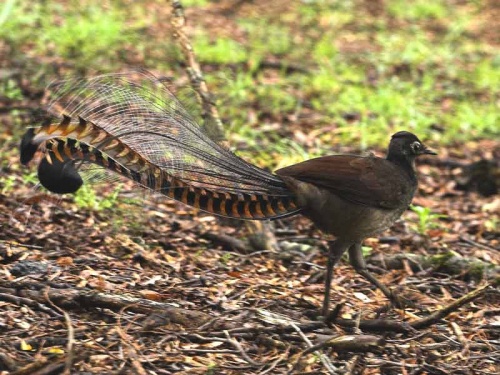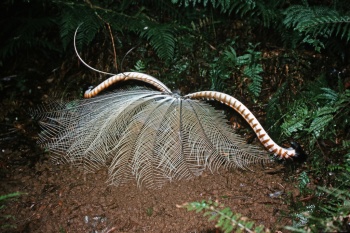m (genus tags added) |
(Imp sizes. Attempt to disguise more copied text. Clearer image of displaying male. References updated.) |
||
| (6 intermediate revisions by 4 users not shown) | |||
| Line 1: | Line 1: | ||
| + | [[Image:Superb_Lyrebird.jpg|thumb|500px|right|Photo by {{user|Broc|Broc}}<br />Melbourne, [[Victoria]], [[Australia]], April 2006]] | ||
;[[:Category:Menura|Menura]] novaehollandiae | ;[[:Category:Menura|Menura]] novaehollandiae | ||
| − | + | ||
==Identification== | ==Identification== | ||
| − | + | [[Image:Superb-Lyrebird-display2.jpg|thumb|350px|right|Displaying male<br />Photo by '''[http://www.birdforum.net/member.php?u=49168 Hans&Judy Beste]'''<br />Sherbrooke Forest, [[Victoria]], [[Australia]], 1977]] | |
| + | Male 103 cm (40½ in), female 76–80 cm (30-31½ in) | ||
| + | *Dark greyish to brown upperparts | ||
| + | *Greyish-brown underparts | ||
| + | *Rounded wings and strong legs. It is the longest and third heaviest of all songbirds.<br /> | ||
| + | '''Male''': tail has sixteen feathers, with the two outermost being lyre-shaped. It takes seven years for the tail to fully develop. | ||
==Distribution== | ==Distribution== | ||
| − | + | South-eastern [[Australia]], from southern [[Victoria]] to south-eastern [[Queensland]]. | |
==Taxonomy== | ==Taxonomy== | ||
| + | ====Subspecies==== | ||
| + | There are 3 subspecies<sup>[[#References|[1]]]</sup>: | ||
| + | *''M. n. edwardi'': | ||
| + | :*Eastern [[Australia]] (extreme south-eastern [[Queensland]] to Hunter River, [[New South Wales]]) | ||
| + | *''M. n. novaehollandiae'': | ||
| + | :*South-Eastern Australia (central New South Wales to [[Victoria]] border) | ||
| + | *''M. n. victoriae'': | ||
| + | :*South-Eastern New South Wales to Dandenong Range, Victoria; introduced southern [[Tasmania]] | ||
==Habitat== | ==Habitat== | ||
Forests. | Forests. | ||
==Behaviour== | ==Behaviour== | ||
| − | The female builds a domed nest | + | ====Breeding==== |
| − | + | The female builds a domed nest laying a single egg. | |
| − | |||
| + | During courtship display, the male's tail is fanned forward over his head and forms a silver umbrella. | ||
| + | ====Diet==== | ||
| + | Their diet consists of both adult and immature invertebrates foraged both from under the bark and from the ground. They also eat some seeds. | ||
| + | ====Vocalisation==== | ||
| + | Calls are very varied; they are great mimics and will even learn car alarm and chain saw sounds. One was captured in an iconic Sir David Attenborough clip | ||
| + | http://www.youtube.com/watch?v=VjE0Kdfos4Y | ||
| + | ==References== | ||
| + | #{{Ref-Clements6thAug17}}#Handbook of the Birds of the World Alive (retrieved Nov 2017) | ||
| + | {{ref}} | ||
==External Links== | ==External Links== | ||
{{GSearch|Menura+novaehollandiae}} | {{GSearch|Menura+novaehollandiae}} | ||
| − | + | <br /> | |
| − | [[Category:Birds]][[ | + | {{Video|Superb_Lyrebird}} |
| + | |||
| + | [[Category:Birds]] [[Category:Menura]][[Category:Videos]] | ||
Revision as of 21:12, 13 November 2017
- Menura novaehollandiae
Identification
Male 103 cm (40½ in), female 76–80 cm (30-31½ in)
- Dark greyish to brown upperparts
- Greyish-brown underparts
- Rounded wings and strong legs. It is the longest and third heaviest of all songbirds.
Male: tail has sixteen feathers, with the two outermost being lyre-shaped. It takes seven years for the tail to fully develop.
Distribution
South-eastern Australia, from southern Victoria to south-eastern Queensland.
Taxonomy
Subspecies
There are 3 subspecies[1]:
- M. n. edwardi:
- Eastern Australia (extreme south-eastern Queensland to Hunter River, New South Wales)
- M. n. novaehollandiae:
- South-Eastern Australia (central New South Wales to Victoria border)
- M. n. victoriae:
- South-Eastern New South Wales to Dandenong Range, Victoria; introduced southern Tasmania
Habitat
Forests.
Behaviour
Breeding
The female builds a domed nest laying a single egg.
During courtship display, the male's tail is fanned forward over his head and forms a silver umbrella.
Diet
Their diet consists of both adult and immature invertebrates foraged both from under the bark and from the ground. They also eat some seeds.
Vocalisation
Calls are very varied; they are great mimics and will even learn car alarm and chain saw sounds. One was captured in an iconic Sir David Attenborough clip http://www.youtube.com/watch?v=VjE0Kdfos4Y
References
- Clements, J. F., T. S. Schulenberg, M. J. Iliff, D. Roberson, T. A. Fredericks, B. L. Sullivan, and C. L. Wood. 2017. The eBird/Clements checklist of birds of the world: v2017, with updates to August 2017. Downloaded from http://www.birds.cornell.edu/clementschecklist/download/
- Handbook of the Birds of the World Alive (retrieved Nov 2017)
Recommended Citation
- BirdForum Opus contributors. (2024) Superb Lyrebird. In: BirdForum, the forum for wild birds and birding. Retrieved 18 April 2024 from https://www.birdforum.net/opus/Superb_Lyrebird
External Links





